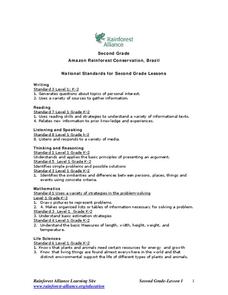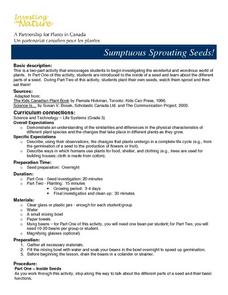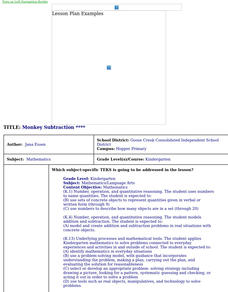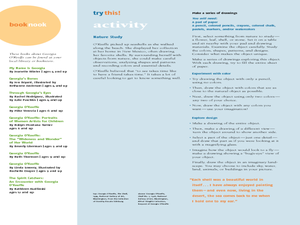Curated OER
Wetland Plant Detectives
Sixth graders identify plants in the wetlands. In this plant detectives lesson plan, 6th graders complete a scavenger hunt on a local reserve, record observations, and respond in their journals.
Curated OER
The Discovery of Photosynthesis
Young scholars explore how scientists discover photosynthesis. In this biology instructional activity, students identify the basic requirements for photosynthesis to happen. They recreate past scientists' experiments and record their...
Curated OER
Transition to algebra
Young scholars recognize the difference between a prime and a composite number. In this prime and composite number lesson, students use a factor tree model to show prime factorization. Young scholars participate in a bingo...
Curated OER
Collecting Leaves with Lewis and Clark
Fourth graders collect data on leaves collected, observe different species of leaves, and implement different methods of leaf preservation.
Curated OER
Capillary Action and Adhesion
Students perform classroom experiments to observe adhesion. They perform a second experiment using sand, salt, water, and a heat lamp to observe the principle of capillary action. They also experiment with adhesion in plants.
Curated OER
A Lovely Captive
Fourth graders construct a habitat which allows them to observe the metamorphosis of a caterpillar into a butterfly. They place a plate on the bottom of the cylinder to serve as a landing platform. They use the cage for keeping adult...
Curated OER
Literature and the Scientific Method
In this scientific method worksheet, young scholars read a poem and describe how the poem illustrates the importance of observation in the scientific method. This worksheet has 3 short answer questions.
Curated OER
The Changing Earth
Students observe and analyze weathering. In this earth science lesson plan, students demonstrate physical and chemical weathering in two experiments, then write questions for a class Jeopardy game.
Curated OER
Terrariums: A Look at the Living and Nonliving World
Third graders examine life in a terrarium and relate it to life in a larger environment. In this terrarium lesson, 3rd graders examine how living and non-living things work together by examining the changes in a terrarium. They make...
Curated OER
Amazon Rainforest Conservation, Brazil
Students explore rain forests. In this rain forest lesson, students participate in a "BioBlitz" of their schoolyard, observing and recording every living thing in a designated area. Students visit websites about rain forests...
Curated OER
Principles Of Flight: Wings That Spin
Students discover how flight is possible. For this physics lesson, students investigate the properties of a blimp and gyro-copter, comparing rotating wings and fixed wings of aircraft. Students create their own model aircraft...
Curated OER
The Froggy Page
Students investigate the cycle of life by observing tadpoles. In this biology lesson, students utilize the Internet to read stories, observe pictures, and listen to sounds of frogs. Students create a poster board collage...
Curated OER
Sumptuous Sprouting Seeds!
Third graders investigate the wonderful and wondrous world of plants. They examine the inside of a seed, explore the different parts of a seed, plant their own seeds, watch them sprout and then eat them! They describe, using their...
Curated OER
Monkey Subtraction
Students listen to the book Five Little Monkeys Sitting In a Tree, identify written numbers 0-9 and the symbol for subtraction; students subtract two single digit numbers using manipulatives, and recite the corresponding number sentence.
Curated OER
Arthropods at Home: Spider, Isopod, or any Arthropod
Second graders observe, discuss, and record the requirements of a healthy environment for both arthropods and people by designing and maintaining an artificial habitat for an arthropod, and considering the requirements for a healthy body...
Curated OER
Tadpole Diary
Second graders examine the life cycle by observing tadpoles. After reading the book, Tadpole Diary, they draw the stages of tadpole development and write sentences about what they think is happening.
Curated OER
Extraction of Caffeine from Tea Leaves
Students conduct an experiment in which they extract the greatest number of grams of caffeine from four bags of tea. They conduct Internet research, conduct the experiment, and record their observations and data.
Curated OER
Sunny Sunflowers
First graders, after assessing how plants grow in relation to light, create models of sunflowers within a game to help them remember their science lesson. In addition, their visual models serve as a demonstration of photo tropism in...
Curated OER
Mad Science Lab: Original Lesson Plan
Young scholars conduct a number of simple experiments, collect and categorize the results as either chemical or physical change. The lesson uses connections to folklore, science fiction and comic books to assist each student as they make...
Curated OER
Pictures Make Perfect!
Students observe and demonstrate how to visualize the information they are reading. They participate in a visualization exercise, and discuss how visualizing information from the text can improve their comprehension. Students then read...
Curated OER
Letter Booklets: Qq to Zz
In these recognizing letters of the alphabet worksheets, students identify each letter Qq to Zz, and create booklets of each letter, trace and write the upper case and lower case letters, observe pictures of words with the beginning...
Curated OER
Leaf Chromatography
In this leaf chromatography worksheet, learners separate the pigments of a leaf using paper chromatography. They answer 4 questions about their results and draw the colors they observe on their chromatogram from the leaf.
Curated OER
Get to Know- Insects, Spiders and Others
Learners investigate live insects. In this insects and spiders lesson, students work in groups to explore the outdoors and capture insects. Learners observe, discuss and record information about the insects they discover. Students...
Curated OER
The Beautiful Works of Georgia O'Keefe
Students discover the art of Georgia O'Keefe. In this art history lesson plan, students investigate the influential power nature has on art. Students create their own works of art by observing local nature.























